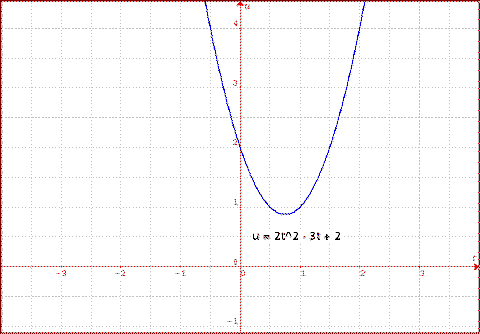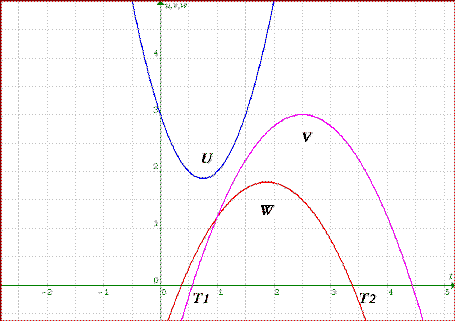Dimension Definition Types
You can select the approach for STK to take to determine the dimensions of the threat volume. Use the Main page of the Advanced CAT Basic properties to select one of the following dimension definition types:
Dimension Definition Types
Two of these are fixed definition types: Fixed and Orbit Class.
Two others yield dimensions varying dynamically over time via quadratic equations: Quadratic and Quadratic Orbit Class (Quad/Orb).
The last two, Covariance and CovOffset, are defined by positional covariance.
Fixed definition types
If you select Fixed as the Class type, specify the dimensions as described here.
If you select Orbit Class as the Class type, STK employs a table lookup system. First, STK assigns the object of interest a numerical ID on the basis of its apogee and perigee. The following figure represents a graphical representation of an example table for determining the orbit class of an object.

Using this example table, STK would assign an ID of (21) to an object with an apogee of 17,000 km and a perigee of 7,000 km. The database file has a second table that connects each numerical ID with a set of three indices representing the dimensions of the threat volume ellipsoid. In this case, STK would use this second table to look for orbit class ID 21 and extract its corresponding threat volume values for tangential, cross-track, and radial.
The lookup table (database file) takes the form of an FOC text file (*.foc extension). You can add your own propriety Orbit Class files using the prescribed FOC file format. To select among Orbit Class files, open the Advanced page under Basic properties for the Advanced CAT object and click the ellipsis (![]() ) to the right of the Fixed Orbit Class Database field.
) to the right of the Fixed Orbit Class Database field.
If an Orbit Class definition fails, STK applies the Fixed default values. A failure would occur if there is no FOC database or because the satellite's apogee or perigee does not fall within any database ranges.
Quadratic definition types
The Quadratic and Quadratic Orbit Class (Quad/Orb) definition types define the dimensions of the threat volume ellipsoid on the basis of quadratic equations, with t = time past satellite (or TLE) epoch as the independent variable. For each dimension, the database provides the coefficients a, b, and c for an equation of the form:
U(or V or W) = at2 + bt + c
where U, V, and W represent, respectively, the normal, tangential (in-track), and cross-track directions. Thus, each of the three dimensions defines a parabolic plot over time, such as that shown in the following graph, where a = 2, b = -3, and c = 2.

In some cases, such as the following (where a = -1.5, b = 7, and c = -3), portions of the parabola for one or more dimensions will lie at or below zero.

In such cases, STK applies the following rule:
At any time when the value of the quadratic equation for any or all dimensions is equal to or less than zero, the threat volume of an object is defined as a point at the center of the object for so long as that condition holds.
In the case illustrated in the following graph, there are times at which the equation for V (normal), W (tangential), or both V and W, yields values less than or equal to zero:

Applying the above rule, the threat volume will be defined as a point rather than as an ellipsoid except when the values of both the V and W equations are greater than zero. That is, the threat volume will be treated as a point at any time before the time labeled T1 in the above graph or after the time labeled T2.
If you select the Quadratic Orbit Class (Quad/Orb) definition type, Advanced CAT uses a lookup table system like the Fixed Orbit Class type. It first determines a numerical ID based on the apogee and perigee of the object in question. Each ID in the QOC database file (*.qoc extension) corresponds to nine indices, consisting of a set of three coefficients for each axis (U, V, and W). See the section on QOC file format for more details.
If you select the Quadratic type, Advanced CAT queries the QDB database file (*.qdb extension) for the nine indices correspnding to the object's SSC number or common name, not an orbit class ID. See the section on QDB file format for more details.
If the Quadratic Orbit Class (Quad/Orb) type fails, Advanced CAT tries the Orbit Class (fixed) type. If that also fails, it uses the default values for the Fixed ellipsoid. If the Quadratic type fails, perhaps because no SSC number is available for the object, Advanced CAT resorts first to the Quadratic Orbit Class type, then to the Orbit Class (fixed) type, and then to the default values for the Fixed type.
You can add your own proprietary Quadratic (*.qdb) or Quadratic Orbit Class (*.qoc) files using the prescribed file formats. To select among database files, open the Advanced page under Basic properties for the Advanced CAT object and click the ellipsis (![]() ) to the right of the database field of interest.
) to the right of the database field of interest.
FOC file format
An FOC file has no header nor keyword information other than the BEGIN and END keywords for the ORBIT_CLASS_DEFINITION section and the ORBIT_CLASS_INDEX_ASSIGNMENT section. For the ORBIT_CLASS_DEFINITION, the columns follow this construction:
| Column | Description |
|---|---|
| 1 | Orbit class number (positive integer) |
| 2 | lower apogee limit (in kilometers) |
| 3 | Upper apogee limit (in kilometers) |
| 4 | Lower perigee limit (in kilometers) |
| 5 | Upper perigee limit (in kilometers) |
For the ORBIT_CLASS_INDEX_ASSIGNMENT section, the columns follow this construction:
| Column | Description |
|---|---|
| 1 | Orbit class number (positive integer) |
| 2 |
Normal (radial) dimension of the threat ellipsoid (in kilometers) |
| 3 | Tangential (in-track) dimension of the threat ellipsoid (in kilometers) |
| 4 | Cross-track dimension of the threat ellipsoid (in kilometers) |
FOC (*.foc) file example
BEGIN ORBIT_CLASS_DEFINITION 1 0. 300. 0. 300. 2 300. 575. 0. 300. 3 300. 575. 300. 575. 4 575. 1000. 0. 300. 5 575. 1000. 300. 575. 6 575. 1000. 575. 800. ... END ORBIT_CLASS_DEFINITION BEGIN ORBIT_CLASS_INDEX_ASSIGNMENT 1 20.0 10.0 5.0 2 25.0 15.0 10.0 3 25.0 15.0 10.0 4 30.0 20.0 15.0 5 35.0 25.0 15.0 6 40.0 30.0 20.0 ... END ORBIT_CLASS_INDEX_ASSIGNMENT
QOC file format
A QOC file has no header nor keyword information other than the BEGIN and END keywords for the QUADRATIC_ORBIT_CLASS_DEFINITION section and the QUADRATIC_ORBIT_CLASS_INDEX_ASSIGNMENT section. The format for the QUADRATIC_ORBIT_CLASS_DEFINITION is the same as for the FOC file. For the QUADRATIC_ORBIT_CLASS_INDEX_ASSIGNMENT section, the columns follow this construction:
| Column | Description |
|---|---|
| 1 | Orbit class (positive integer) |
| 2 |
A single-letter identifier for the dimension U = normal (radial) V = tangential (in-track) W = cross-track |
| 3 | the scalar coefficient (c) value |
| 4 | The linear coefficient (b) value |
| 5 | The quadratic coefficient (a) value |
QOC (*.qoc) file example
BEGIN QUADRATIC_ORBIT_CLASS_INDEX_ASSIGNMENT 3 U 0.775719D+00 0.1282532050D-04 -.33569482232572D-09 3 V 0.745229D+00 0.4004648442D-04 0.97675366631565D-08 3 W 0.688041D+00 0.1672772275D-04 -.16541946542111D-09 4 U 0.805555D+00 0.5800554748D-05 0.14030110603657D-09 4 V 0.624537D+01 0.3096983616D-03 0.64076969275586D-08 4 W 0.376469D+01 0.7453608749D-05 -.55824443945301D-10 5 U 0.681798D+01 -.1573875151D-02 0.89659762776563D-07 5 V 0.319341D+02 0.1426961030D-01 0.44141371602587D-06 5 W 0.135993D+01 0.2903580979D-04 -.47126386542394D-10 ... END QUADRATIC_ORBIT_CLASS_INDEX_ASSIGNMENT BEGIN QUADRATIC_ORBIT_CLASS_DEFINITION 3 300. 575. 300. 575. 4 575. 1000. 0. 300. 5 575. 1000. 300. 575. ... END QUADRATIC_ORBIT_CLASS_DEFINITION
QDB file format
A QDB file has no header nor keyword information. The columns follow this construction:
| Column | Description |
|---|---|
| 1 | Not used |
| 2 | SSC number or common name (positive integer or letters) |
| 3 |
A single-letter identifier for the dimension U = normal (radial) V = tangential (in-track) W = cross-track |
| 4 | The scalar coefficient (c) value |
| 5 | The linear coefficient (b) value |
| 6 | The quadratic coefficient (a) value |
| 7 | Not used |
| 8 | Not used |
This file is in a government-established format and so contains some columns that are not relevant to the Advanced CAT purposes.
QDB (*.qdb) file example
U 10893 U 0.805555D+00 0.4800554748D-00 0.14030110603657D-09 51 A U 10893 V 0.624537D+01 0.7096983616D-00 0.64076969275586D-08 51 A U 10893 W 0.376469D+01 0.7453608749D-00 -.55824443945301D-10 51 A U 10894 U 0.681798D+01 -.1573875151D-02 0.89659762776563D-07 43 A U 10894 V 0.319341D+02 0.1426961030D-01 0.44141371602587D-06 43 A U 10894 W 0.135993D+01 0.2903580979D-04 -.47126386542394D-10 43 A U MIR U 0.775719D+00 0.1282532050D-04 -.33569482232572D-09 11 A U MIR V 0.745229D+00 0.4004648442D-04 0.97675366631565D-08 11 A U MIR W 0.688041D+00 0.1672772275D-04 -.16541946542111D-09 11 A U 10917 U 0.775719D+00 0.1282532050D-04 -.33569482232572D-09 11 A U 10917 V 0.745229D+00 0.4004648442D-04 0.97675366631565D-08 11 A U 10917 W 0.688041D+00 0.1672772275D-04 -.16541946542111D-09 11 A